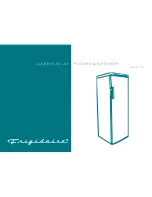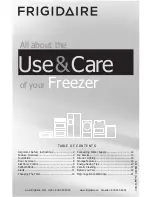
7
merchandiser. On outdoor cabinet models, the melt
water will exit the drain tube directly to the ground.
On indoor cabinet models, the consumer needs to
install the condensate evaporator heater assembly
(described in the
Installation
section of this
manual) onto the exterior back wall of the cabinet.
The melt water from the defrost cycle will drain
into a catch pan where it will then be heated to the
point of evaporation. The function of the condensate
evaporator’s heat element should be checked
routinely. Failure of the element could result in an
over-flow condition for the assembly’s drain pan.
A simple check of the heater would be a touch test
of the surface temperature of the assembly’s
housing. The condensate evaporator’s heat element
is energized continuously so the surface of the
housing should always be hot to the touch. If testing
the heat element with a meter, the element can be
unplugged from its’ power source and a resistance
reading can be taken through the plug’s bladed
terminals. The condensate heater is rated to generate
125 watts of power, which translates to
approximately 106 ohms of resistance.
It is recommended to check the operation and
condition of the evaporator coil and for signs of
excessive ice buildup every 3 months
Auto-Defrost Electronic Control:
The AD
freezer comes equipped with an electronic control
(as described in the OPERATION section of this
manual). The timer is factory set for a 24 minute
defrost cycle to occur at 4-hour intervals. Like a
mechanical timer, the electronic control will switch
power from run mode (condensing unit and
evaporator fans) to defrost mode (defrost heat
element). Whereas the mechanical timer operates
strictly on a timed cycle, the duration of the
electronic control’s defrost cycle is controlled by
the temperature at the sensor probe “P2.” If the
temperature at this probe reaches 60° prior to the
24-minute timed cycle ending, the control will
override the timed cycle and immediately switch
power from the defrost mode to the run mode. If
temperature is not reached at probe “P2,” the
defrost cycle will continue for the entire 24-minute
programmed cycle prior to returning to run mode.
Energizing the defrost circuit in the electronic
control can be verified with the illumination of the
“melting snowflake” and the letters “DE” appearing
on the control’s display screen.
The electronic defrost circuit is equipped with a
defrost termination safety switch and is attached to
one of the evaporator coil tubes (located inside the
Unit Cooler Assembly). This switch senses
temperature and will cut power to the defrost heat
element should the temperature at the surface of the
switch reach 100° F. This switch only terminates
power to the heat element and will not end the
timed / temperature defrost cycle. Once the
merchandiser has returned to run mode, the
termination safety switch will re-set when the
temperature at its’ surface reaches 70° F.
Warning!
The defrost termination / safety switch
functions as a possible fire protection device. Do
not remove or by-pass the switch from the defrost
circuit.
Note:
If an electronic control AD unit loses power,
it will automatically enter a defrost cycle.
Note:
Certain models may contain a drain line
heater to prevent ice from forming inside the drain
tube.
Solid Door Models and Maintenance:
Cabinets designed for outdoor use will have a metal
clad door that has been insulated with the same
urethane foam insulation as the cabinet. For routine
cleaning of the door’s exterior surface, a mild
detergent diluted in warm water should be adequate.
Routine inspection of the door gasket seal is
recommended. If damage has occurred, replace the
gasket.
Hinge Spring Tension:
A simple test of the
spring-load tension is to open the door just enough
to insert two fingers between the surface of the
cabinet and the handle side of the door. When the
fingers are withdrawn, there should be enough
tension set on the hinge spring-loads to slowly
move the door to a closed position. If the door does
not move from this two-finger location, it’s likely
that either the spring-load requires re-tensioning or
































